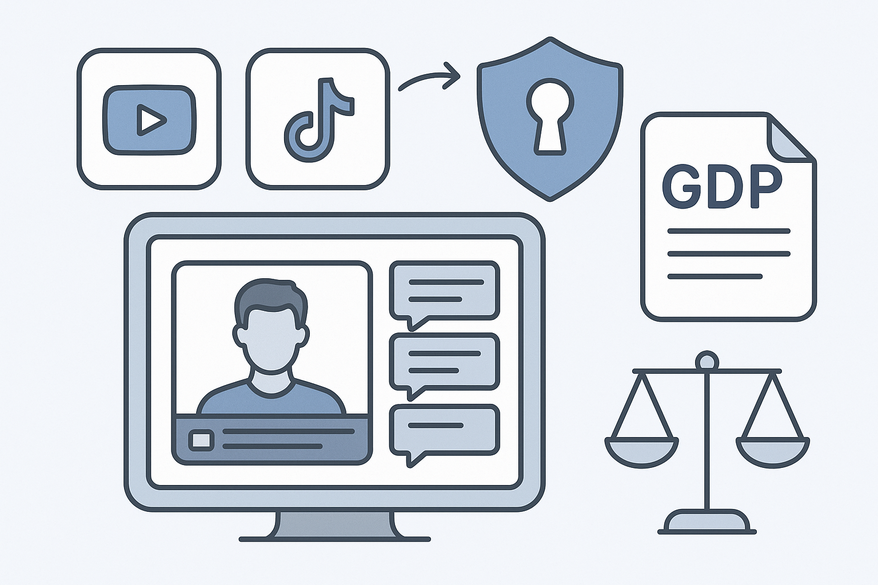GDPR Compliance for Fake Chat Videos: A Crucial Guide
Learn how to ensure GDPR compliance for fake chat videos on platforms like YouTube and TikTok, maintaining privacy while avoiding legal risks.

Estimated reading time: 8 minutes
Key Takeaways
- Treat realistic simulated chats as personal data under GDPR.
- Label all videos clearly as “Fictional” or “AI-Generated.”
- Obtain explicit consent or anonymize personal details.
- Maintain detailed records and conduct regular compliance audits.
- Use moderation tools and persistent disclaimers to mitigate legal risks.
Table of Contents
- Section 1: Understanding GDPR & Fake Chat Videos
- Section 2: EU Data Rules and Impact
- Section 3: GDPR Guidelines for Creators
- Section 4: Practical Tips and Tools
- Conclusion & Further Resources
Section 1: Understanding GDPR in the Context of Fake Chat Videos
What Is GDPR?
GDPR is an EU regulation that governs any processing (collection, storage, use, disclosure) of personal data belonging to EU residents. Its aim is to protect individual privacy and give people control over their personal information.
Processing and Simulated Content
• “Processing” covers any handling of personal data.
• Even if your chat logs are fully invented or AI-generated, GDPR may apply if they mimic a real person or show realistic personal details.
Fictional vs. Genuine Data
• Fully fictional chats are safe—unless they resemble an actual person.
• If viewers could mistake your video for real life, treat it like genuine data and apply GDPR rules.
Risks of Non-Compliance
- Fines up to €20 million or 4% of global turnover
- Platform takedown demands or lawsuits
- Damage to your reputation and channel trust
- Growing scrutiny as deepfake and AI tools become more powerful
Learn more about legal risks and best practices.
“A small creator used a stock photo and made up a story about ‘Emily.’ Viewers shared it as fact. Soon, the real Emily found out and filed a complaint. The video was removed and the creator faced a formal GDPR warning.”
Section 2: EU Data Rules and Their Impact on Chat Story Videos
Consent & Transparency Obligations
• Use of real or convincingly simulated personal data requires clear, informed consent from the person portrayed.
• If you can’t get consent, label your content “Fictional” or “AI-Generated” at the start and in the description.
Emerging Disclosure Rules
The EU is moving toward mandatory labels for deepfake or AI-manipulated media. Soon, viewers may see a clear tag that content is altered or fabricated.
Case Study – YouTube Deepfake Phishing Scams
In late 2023, fraudsters repurposed creators’ voices and chat screenshots to phish subscribers. This underscored:
- The need for robust content controls
- Audience disclaimers to prevent misunderstandings
Section 3: GDPR Guidelines for Chat Video Creators
Compliance Checklist (Must-Do)
- Label all chat videos as “Fictional” or “AI-Generated” at the start and in descriptions.
- Never use real individuals’ names, images, or personal data without explicit, documented consent.
- Anonymize or aggregate any real data snippets: see how to anonymize fake chat videos.
- Include a persistent privacy notice/disclaimer in your channel “About” or video description.
- Keep internal records of your creation process, including AI tools used and data sources consulted.
- Monitor audience feedback for misinterpretations or unauthorized reuse.
- Watch for copycat or malicious derivatives (e.g., phishing deepfakes) and issue takedown requests if needed.
Experience Tip: A mid-sized channel did a quarterly check and found one old video that used a real phone number. They removed it, issued an apology, and updated their workflow to block personal data.
Section 4: Practical Tips and Tools
Content-Moderation & Verification Tools
• Use script-scanning platforms to detect unintentional real personal data.
• Employ subtitle checkers to flag names, email addresses, and phone numbers.
Standardized Disclaimer Templates
“Disclaimer: This video contains fictional or AI-generated content. No real individuals were depicted.”
Consent Management Platforms (CMPs)
• Integrate a lightweight pop-up or banner on your website landing pages to collect and store user consent strings.
• Watch out for fraudulent consent strings in ad tech that may invalidate your legal basis.
Stay Updated
Subscribe to EU Commission newsletters on AI, media regulation, and data protection updates.
Check out Vidulk - Fake Text Message Story App for more automated privacy safeguards.
Conclusion and Further Resources
GDPR compliance for fake chat videos matters because it:
- Protects individual privacy and your channel’s reputation
- Meets EU data rules chat story videos require
- Follows GDPR guidelines for chat video creators with clear labels, consent, and records
Staying compliant builds trust, avoids fines, and future-proofs your content as AI and deepfakes evolve.
Further Reading & Hyperlinks
- European Commission official GDPR page
- ICO guidance on GDPR and AI content
- “Harmful deepfakes and the GDPR” by Martijn van der Helm
- YouTube Creator Guidelines on manipulated content transparency
FAQ
Q: What qualifies as personal data in a fake chat video?
A: Anything that could identify a real person—names, photos, contact details or closely mimicked traits—must be treated as personal data under GDPR.
Q: How should I label my simulated chat content?
A: Include clear tags like “Fictional” or “AI-Generated” at the video’s start and in the description to meet transparency requirements.
Q: What if I can’t get consent from a real person?
A: You must either anonymize the data completely or ensure your content is unmistakably fictional, with no real-world claims or identifiers.





